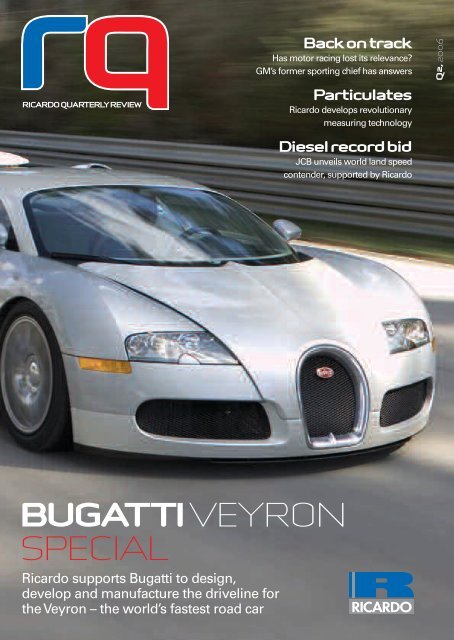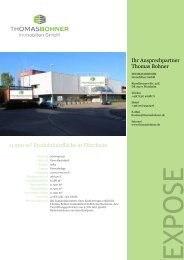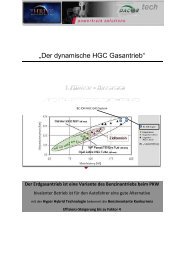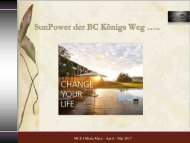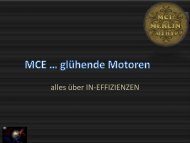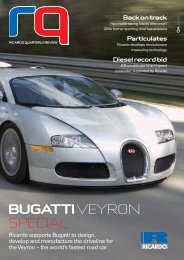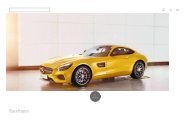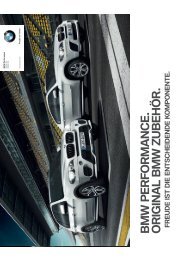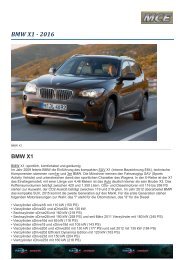EX3 BUGATTI VEYRON SPECIAL - Ricardo MCE
You also want an ePaper? Increase the reach of your titles
YUMPU automatically turns print PDFs into web optimized ePapers that Google loves.
Back on track<br />
Has motor racing lost its relevance?<br />
GM’s former sporting chief has answers<br />
Q2,2006<br />
RICARDO QUARTERLYREVIEW<br />
Particulates<br />
<strong>Ricardo</strong> develops revolutionary<br />
measuring technology<br />
Diesel record bid<br />
JCB unveils world land speed<br />
contender, supported by <strong>Ricardo</strong><br />
<strong>BUGATTI</strong><strong>VEYRON</strong><br />
<strong>SPECIAL</strong><br />
<strong>Ricardo</strong> supports Bugatti to design,<br />
develop and manufacture the driveline for<br />
the Veyron – the world’s fastest road car
“The most advanc e<br />
Bugatti Veyron<br />
One thousand and one horsepower, sixteen cylinders, seven speeds and over<br />
400km/h – transmission engineering challenges don’t come much tougher<br />
than Bugatti’s fabulous million-euro Veyron supercar.Tony Lewin reports on<br />
the support provided by <strong>Ricardo</strong> in the development and manufacture of one<br />
of the most sophisticated driveline systems ever conceived<br />
It’s the front-cover splash of almost<br />
every car magazine in the world.<br />
Everywhere, writers are struggling<br />
to find new superlatives to describe its<br />
astonishing performance. And<br />
everywhere the message is the same:<br />
this million-euro machine redefines,<br />
dramatically and decisively, our idea<br />
of what a car can do.<br />
The concept of a road car faster than<br />
a Formula One car is no longer fantasy<br />
but fact; thanks to Bugatti, this<br />
remarkable display is now seen as<br />
achievable with a car that’s also<br />
elegant, luxurious and refined, and<br />
which does not demand racing-driver<br />
skills at the wheel.<br />
Bugatti has defied the doubters and<br />
proved that 400 km/h and first-class<br />
comfort can indeed go together. Yet<br />
with expectations so suddenly and so<br />
dramatically transformed, it is all too<br />
easy to forget what a monumental<br />
technical achievement the Veyron<br />
represents. It is especially important to<br />
recall that, at the time it was originally<br />
proposed in 2000, the idea of the 1001<br />
horsepower sports car seemed a nighon<br />
impossible technical challenge.<br />
VW chief astounds the industry<br />
A moment of stunned silence gripped<br />
the audience of international<br />
08 RICARDO QUARTERLY REVIEW • Q2, 2006
ed car of our time”<br />
automotive journalists as the crowd of<br />
normally talkative reporters choked in<br />
disbelief at what they had just heard.<br />
The scene was the Nogaro Hilton<br />
Hotel in Geneva in March 2000, when<br />
correspondents had assembled to<br />
hear Volkswagen’s then CEO, Dr<br />
Ferdinand Piëch, deliver his annual<br />
state-of-the-union address to the<br />
world’s business and technical media:<br />
in the middle of a long stream of<br />
corporate results, sales predictions<br />
and bland technical statistics, Dr Piëch<br />
had casually tossed in the number<br />
which was to astound everyone – one<br />
thousand and one horsepower.<br />
For this, said Dr Piëch, would be the<br />
power output of the new Bugatti<br />
Veyron sports car. Only the absolute<br />
ultimate in power, performance and<br />
sophistication would suffice for the<br />
21st century revival of what had in its<br />
heyday been the most glamorous<br />
marque in the world. “This will be the<br />
most exciting and most advanced car<br />
of its time, no more, no less,” he<br />
predicted.<br />
Previously, only a select few racing<br />
cars had breached the thousandhorsepower<br />
mark. It would clearly be a<br />
major technical challenge to feed this<br />
power to the road safely enough for<br />
drivers with standard rather than<br />
competition licences: delivering such<br />
stupendous performance with the<br />
smoothness and refinement demanded<br />
by an elite millionaire clientele was<br />
likely to be a bigger issue still.<br />
Bugatti’s Heritage<br />
It is difficult from today’s perspective<br />
to imagine the awe in which the<br />
Bugatti marque was held during its<br />
1920s and 1930s golden age. Its sports<br />
and racing cars were engineered with<br />
absolute purity of focus, always light,<br />
ingenious and elegant; the integrity of<br />
the road-car chassis attracted the very<br />
best coachwork builders of the era,<br />
producing style landmarks such as the<br />
Atlantique coupé and, at the opposite<br />
end of the scale, the mammoth Type<br />
41 Royale. In its exotic aura Bugatti<br />
was the Ferrari of its time, but with the<br />
equivalent of Rolls-Royce luxury,<br />
radical thinking from Lotus and hardwired<br />
race heritage from McLaren<br />
thrown in too.<br />
Undeniably, the task of<br />
reinterpreting this unmatched legend<br />
for the 21st century customer has<br />
been a daunting one. Accordingly,<br />
Volkswagen decided to call upon the<br />
Q2, 2006 • RICARDO QUARTERLY REVIEW 09
Bugatti Veyron<br />
With seven speeds, dual clutches, four wheel drive and an active rear axle,<br />
the Veyron driveline (right) is one of the most complex ever bulit<br />
very best skills on offer among the<br />
world’s automotive engineering<br />
providers to ensure the born-again<br />
Bugatti would satisfy the<br />
extremely high demands<br />
placed on it by customers<br />
whose automotive<br />
portfolios already include<br />
the likes of Bentley,<br />
Ferrari, Porsche and<br />
Mercedes-Benz.<br />
For the embryo Bugatti<br />
division, set up under<br />
Volkswagen’s Wolfsburg<br />
roof pending the<br />
completion of the Bugatti<br />
Atelier at the marque’s<br />
famous Molsheim home<br />
across the border in France,<br />
<strong>Ricardo</strong> was the natural choice<br />
of engineering partner for the<br />
transmission and driveline system.<br />
Michael Kodra, Bugatti engineer in<br />
charge of the liaison with <strong>Ricardo</strong><br />
throughout the programme, explains:<br />
“We had already worked with<br />
<strong>Ricardo</strong> on smaller programmes – they<br />
built the axles for two different show<br />
cars that were presented, and these<br />
axles worked perfectly and without any<br />
further problems. We also needed a<br />
company which could supply us with a<br />
gearbox at low volume: most of the<br />
other big gearbox suppliers are seeking<br />
to make money through volumes, and<br />
we can only offer a run of about 300.<br />
Thanks to this and our previous<br />
experience with them on the W18 and<br />
W12 sports car, we decided that<br />
<strong>Ricardo</strong> would be the best company to<br />
support us on this job.”<br />
<strong>Ricardo</strong>’s biggest-ever driveline<br />
programme<br />
Though <strong>Ricardo</strong> enjoys an<br />
unparalleled reputation in the field of<br />
ultra high performance transmission<br />
systems across both sports and racing<br />
cars (providing drivelines for the<br />
Jaguar XJ220, McLaren F1 and Audi’s<br />
Le Mans winners, for example), once<br />
the specification of the Veyron was<br />
revealed it soon became clear that the<br />
Bugatti transmission system would be<br />
much the most sophisticated the<br />
company had ever built. As a result,<br />
the programme would be the largest<br />
ever supported by the company’s<br />
driveline and transmission engineers.<br />
Bugatti’s brief called not just for a<br />
seven-speed dual clutch gearbox<br />
capable of handling an unprecedented<br />
1250 Nm of torque, but also for<br />
automated shifting and electrohydraulic<br />
control of all key functions.<br />
The driveline, too, was to be of<br />
exceptional complexity, with drive to<br />
all four wheels, an innovative active<br />
rear axle, a Haldex coupling built into<br />
the front axle, and all the electronic<br />
and hydraulic control systems to<br />
determine not just straightline traction<br />
but high speed vehicle dynamics too.<br />
What at the beginning was simply<br />
an outrageously fast pure sports car<br />
soon found itself doing double duty as<br />
10 RICARDO QUARTERLY REVIEW • Q2, 2006
a much more<br />
luxurious, more<br />
Bentley-like vehicle –<br />
while of course retaining<br />
all its daunting performance<br />
requirements. Attaining all<br />
these demanding design goals,<br />
many of which would<br />
conventionally be seen as totally<br />
incompatible, was a major<br />
achievement by Bugatti and all the<br />
companies<br />
supporting the<br />
Veyron<br />
programme.<br />
Yet, at the<br />
same time,<br />
the fact that<br />
the Veyron<br />
programme<br />
became part of<br />
the mainstream<br />
Volkswagen<br />
product development<br />
process provided what<br />
was to be the most challenging<br />
task of all.<br />
By bringing the Veyron ‘in-house’,<br />
Bugatti’s new technical director,<br />
Dr Wolfgang Schreiber, ensured the<br />
whole vehicle met the same daunting<br />
durability targets that would normally<br />
be fulfilled by standard million-a-year<br />
Golf-platform family cars – models<br />
which have to perform faultlessly in<br />
service over many years of hard use.<br />
Prior to the arrival of the Veyron, the<br />
normal life expectancy for a rare<br />
supercar was frighteningly short, with<br />
numerous pit-stops and replacement<br />
systems required at frequent intervals.<br />
What Schreiber prescribed was<br />
massively more demanding than<br />
anything ever seen among normally<br />
fragile supercars.<br />
The durability requirements make<br />
truly terrifying reading for any<br />
engineer with an ounce of mechanical<br />
sympathy. Given that much of its<br />
50,000 km is driven with the<br />
thousand-horsepower engine at full<br />
throttle, the Veyron’s transmission<br />
durability programme must rate as<br />
one of the toughest the auto industry<br />
has ever devised.<br />
Mike Everitt, senior programmes<br />
manager at <strong>Ricardo</strong>, believes that this<br />
regime makes the Veyron the<br />
strongest ultra high performance car<br />
ever built. “Wolfgang Schreiber has<br />
genuinely shifted the goalposts in the<br />
supercar segment,” he says.<br />
Big-name supercars all too often<br />
prove fragile in service. It is rumoured<br />
that one model is only capable of<br />
doing three full-bore launches before<br />
the clutch needs to be replaced. The<br />
Veyron, on the other hand, completed<br />
200 consecutive full-throttle launches<br />
with consummate ease. “The testers<br />
only stopped because it was getting<br />
too dark,” remembers Everitt. “The<br />
clutches were still fine.”<br />
“When exposed to the full 1,250 Newton-metres torque of the<br />
16-cylinder engine, the resistance of the air and even the force of<br />
gravity itself seem to have no chance: the EB 16·4 Veyron eats up<br />
the road as if these physical laws had just been abolished”<br />
Bugatti publicity, 2003<br />
Q2, 2006 • RICARDO QUARTERLY REVIEW 11
Bugatti Veyron<br />
“MICHAEL<br />
KODRA<br />
Michael Kodra is<br />
the Volkswagen<br />
group engineer in<br />
charge of liaison<br />
with <strong>Ricardo</strong> and<br />
other key suppliers<br />
Did the experience with <strong>Ricardo</strong><br />
gearboxes on the Audi Le Mans<br />
winners influence your choice of<br />
driveline partner?<br />
No. We started this programme just<br />
before the Audi programme became<br />
public. <strong>Ricardo</strong> always keeps its<br />
other customers secret, so even we<br />
at VW did not know that this work<br />
had been done for Audi in the race<br />
cars.<br />
The driveline for this car is very<br />
complicated and has a huge effect<br />
on the handling and driving<br />
characteristics of the whole vehicle.<br />
How is it that VW can work together<br />
with an outside supplier when it is<br />
really determining how that vehicle<br />
will drive?<br />
Using the knowledge we have<br />
gained through working with<br />
<strong>Ricardo</strong> we have implemented the<br />
correct features into the car, such as<br />
the rear axle differential, the<br />
electronic/hydraulic control, the<br />
Haldex coupling which enables us to<br />
have four wheel drive, and this dual<br />
clutch gearbox. We have been very<br />
successful in learning how to<br />
calibrate and to optimize them.<br />
What about the active rear<br />
differential?<br />
At that time the rear differential<br />
control was something VW had<br />
never had in its ordinary cars: we<br />
were about to introduce it in the<br />
Touareg luxury SUV. This is<br />
definitely an item where we<br />
needed to have a close look and<br />
liaise with these [<strong>Ricardo</strong>] guys<br />
in their work. On the gearbox<br />
side, we have done<br />
the same gearbox, though<br />
much smaller and lighter, for<br />
our ordinary passenger<br />
ranges such as the Golf.<br />
Here, <strong>Ricardo</strong> learned from<br />
VW concerning some<br />
software strategies and<br />
so on. So I think we both share<br />
a little bit, we both learn a<br />
little bit.<br />
Design, development and<br />
manufacture<br />
The complexity of the driveline and its<br />
control system was such that Mike<br />
Everitt and his colleagues at both<br />
<strong>Ricardo</strong> and Bugatti had to bring in<br />
extra engineers to ensure the<br />
programme would keep to the very<br />
demanding schedule set by Bugatti: at<br />
its peak, Bugatti’s engineering team<br />
were supported in the programme by<br />
over 50 <strong>Ricardo</strong> driveline and<br />
transmission engineers, with a further<br />
12 -15 electronics specialists working<br />
on the transmission control system<br />
and additional engineers in vehicle<br />
engineering too. Two <strong>Ricardo</strong><br />
engineers even took up residence in<br />
VW’s home city of Wolfsburg.<br />
“One mustn’t forget the absolute<br />
enormity of the task that faced<br />
Bugatti,” explains Everitt. “It designed<br />
a car that’s not only the fastest and<br />
fastest-accelerating car in the world,<br />
but one which is technically far more<br />
advanced than any of its<br />
predecessors.<br />
“It has far more features in it,”<br />
continues Everitt. “It’s four-wheel<br />
drive, it is turbocharged, it has an<br />
active differential and an active drive<br />
transmission system with dual<br />
clutches. The car is very sophisticated<br />
and is entirely new: new engine, new<br />
driveline, new chassis, new everything<br />
– and it’s attacking the market as the<br />
most prestigious sports car ever built.<br />
It has been a very formidable<br />
challenge.”<br />
Even a quick glance at the cutaway<br />
of the Veyron driveline on page 10<br />
brings home the scale of the multinational<br />
<strong>Ricardo</strong> and Bugatti driveline<br />
team’s achievement. There are no<br />
fewer than 660 part numbers for the<br />
driveline’s 1200 components and the<br />
system breaks new engineering<br />
ground – particularly in its use of<br />
seven forward speeds and twin<br />
clutches, and in its real-time role in<br />
determining high speed vehicle<br />
dynamics through its active rear<br />
differential and Haldex coupling.<br />
The use of ADAMS simulation<br />
modelling of vehicle dynamics<br />
allowed <strong>Ricardo</strong> to provide Bugatti<br />
with much necessary data to develop<br />
and optimise suspension kinematics,<br />
to fine-tune the car’s driving<br />
characteristics and present a range of<br />
options to Bugatti management.<br />
“Bugatti engineers determined what<br />
the preferred calibration was to be,”<br />
says Mike Everitt. “They have been<br />
highly successful in calibrating the car<br />
in precisely the desired manner, with<br />
our assistance. We have helped them<br />
give the Veyron the character they<br />
were looking for.”<br />
Driving the Veyron<br />
As a key figure in the Veyron<br />
development process, Mike Everitt<br />
was familiar with the astonishing<br />
abilities of the 16-cylinder Bugatti long<br />
before the international press was<br />
finally allowed access to the car in<br />
Sicily in October 2005.<br />
While the assembled<br />
correspondents were excited, effusive<br />
and often emotional in their<br />
comments, Everitt retains the levelheaded<br />
detachment of an engineer<br />
professionally reviewing a technical<br />
mission successfully accomplished.<br />
Complex though the transmission<br />
hardware undoubtedly is, he says, the<br />
12 RICARDO QUARTERLY REVIEW • Q2, 2006
MANUFACTURING THE <strong>VEYRON</strong> DCT<br />
<strong>Ricardo</strong> is no stranger to low-volume, high precision transmission<br />
manufacture: its workshops have witnessed the assembly not only of the<br />
drivelines for the McLaren F1, Jaguar XJ220 and Volkswagen W12 Nardo record<br />
breaker, but also five years of Le Mans winners for Audi and numerous other<br />
successful but less well known products. Even so, such is the importance of<br />
Bugatti and the complexity of its driveline that a whole separate area of the<br />
<strong>Ricardo</strong> transmissions facility is dedicated exclusively to the assembly of the<br />
Veyron system.<br />
Conditions in the Bugatti assembly area are akin to those of a scientific clean<br />
room, with each of the driveline’s 1200 components receiving a three-stage<br />
cleaning process – culminating in an ultrasonic phase – before assembly.<br />
Component tolerances are close to aerospace levels at 6-8 microns, and exotic<br />
materials include rare-earth magnets located on the gear selector forks for<br />
extremely precise position sensors mounted on the external casing to monitor<br />
the exact location of selectors. This information is used in the control strategy<br />
and helps rule out double gear engagements.<br />
“This is a very high quality, and clearly very high cost operation,” says Adrian<br />
Turner, manager of <strong>Ricardo</strong>’s low volume production operation, of the<br />
manufacturing process. “It’s more akin to an advanced prototype build than<br />
series production – we call it dedicated cell manufacture.”<br />
The cell system sees two technicians each assemble a single transmission a<br />
week. Each stage of the assembly process is meticulously documented, with<br />
the technician confirming every operation, measuring every tolerance and<br />
critical dimension and noting the thicknesses and positions of all shims<br />
employed. The multi-page document is held in the <strong>Ricardo</strong> database so that any<br />
in-service problems can be traced back to individual parts of known history.<br />
Left: Complex seven-speed dual clutch gearbox<br />
takes one week to assemble at <strong>Ricardo</strong>’s<br />
precision manufacturing facility<br />
key throughout is the software that<br />
controls it – even though the driver is<br />
unlikely ever to sense it doing its job.<br />
Yet even Everitt cannot resist<br />
beaming broadly as he revels in the<br />
experience of driving the sixteencylinder,<br />
400 km/h machine:<br />
“If you are driving the car you just<br />
pull a lever and all you see or sense<br />
(of the gearshifts) is that the rev<br />
counter needle falls or rises: it is slick<br />
and smooth but in the background<br />
there are a dozen valves controlling<br />
key parameters, changing clutch<br />
pressures, shifting which gear is<br />
engaged and which is the next preselected<br />
gear and so on.”<br />
One of the key challenges of the<br />
gearbox is that it has, on VW’s<br />
insistence, a non-interlocked gear<br />
selection system. This enables superfast<br />
shifts but, in contrast to<br />
conventional gearboxes where it is<br />
physically only possible to engage one<br />
gear at a time, the mechanical<br />
arrangement of the Veyron box makes<br />
it theoretically possible to engage up<br />
to four gears at once. It is a vital task<br />
of the control software to ensure that<br />
such a damaging occurrence can<br />
never happen, and to this end <strong>Ricardo</strong><br />
specified twin control networks, each<br />
running on different software codes,<br />
written by different teams using<br />
different methodologies. The task of<br />
the first is to control the transmission,<br />
while the second continuously<br />
monitors it to double check that a<br />
double engagement is not about to<br />
take place.<br />
Surprising though it may seem for a<br />
car of such phenomenal performance,<br />
the concept of everything working<br />
faultlessly and seamlessly in the<br />
background is an important part of the<br />
Bugatti’s make-up – again making a<br />
potent contrast to supercar<br />
competitors which can be famously<br />
temperamental and tricky to drive.<br />
Mike Everitt describes it as silky<br />
smooth and easy. “When the car<br />
accelerates it is so fast that if you have<br />
a clear road in front of you and you<br />
can accelerate up to 150 mph (240<br />
km/h) – which it will do in a matter of a<br />
few seconds – it will be up to fourth or<br />
fifth gear and you really didn’t even<br />
count them.<br />
“If you are not watching the gear<br />
display change or watching the rev<br />
counter needle change, if you’re just<br />
looking at the road and get to 150 mph<br />
and back off, you won’t actually know<br />
what gear you were in because it does<br />
it so smoothly,” he enthuses. “Even if<br />
you were in manual mode, if you don’t<br />
do anything the transmission will shift<br />
up for you anyway when you reach<br />
maximum revs.”<br />
Step-change for VW engineering<br />
From the customer side, VW liaison<br />
engineer Michael Kodra is open in<br />
acknowledging that <strong>Ricardo</strong>’s expertise<br />
has been invaluable:<br />
“I think that by being able to bring<br />
this car to the market with its driving<br />
behaviour every bit as [good as] we<br />
expected it to be, we have done a very<br />
good job. Using the knowledge we<br />
have gained we have implemented the<br />
correct features into the car, such as<br />
the rear axle differential, the<br />
electronic/hydraulic control, the<br />
Haldex coupling which enables us<br />
have four wheel drive, and this dual<br />
clutch gearbox. We have been<br />
successful in achieving a good<br />
calibration and optimisation of them.”<br />
“The toughest part in most<br />
programmes is always the timing,”<br />
explains Kodra. “Right from the<br />
beginning of this job we had a very<br />
tight timetable to get this car into<br />
series production. You need to<br />
remember that almost all the<br />
components of the car are brand new<br />
– the monocoque and suspension, a<br />
complete new engine, gearbox and<br />
axles – all the systems have never<br />
played together in one car. We had this<br />
timetable because the car was<br />
Q2, 2006 • RICARDO QUARTERLY REVIEW 13
Bugatti Veyron<br />
“MIKE<br />
EVERITT<br />
Chief<br />
programmes<br />
engineer Mike<br />
Everitt led the<br />
work on the<br />
Veyron driveline since joining<br />
<strong>Ricardo</strong> in November 2000<br />
<strong>Ricardo</strong> has a lot of experience in high<br />
performance transmissions. Can you<br />
build on designs you have done in the<br />
past, or does it have to be completely<br />
new?<br />
You have to visualize the project as<br />
two distinct elements, the first being<br />
mechanical and the second the<br />
control. For both elements we worked<br />
very closely with the VW/Bugatti<br />
engineering team to ensure both that<br />
they got what they wanted and that<br />
we could incorporate their knowledge<br />
of specific lessons learned from their<br />
own DCT programme in the VW Golf<br />
into the programme.<br />
In terms of the mechanical side it is to<br />
some extent an analytical and<br />
formulaic process, but it is heavily<br />
influenced by the experience base<br />
that <strong>Ricardo</strong> and the VW/Bugatti<br />
engineering teams possess. Knowing<br />
how the transmission needs to be<br />
designed for this sort of application,<br />
with its very demanding and<br />
specialist environment, is something<br />
that few companies have experience<br />
of, but it is ground on which <strong>Ricardo</strong><br />
feels comfortable.<br />
The control element of this gearbox<br />
was, however, the really innovative<br />
side: there are increasing industry and<br />
market moves towards dual clutch<br />
transmissions because of the benefits<br />
you get in fuel economy and<br />
efficiency and driver feel. But to do<br />
something in this area of<br />
performance was quite a challenge:<br />
things that work on a “normal” car<br />
simply don’t just scale up when you<br />
get into this class of vehicle.<br />
When you discuss a programme like this<br />
with a customer, who sets out the basic<br />
principles? Did VW simply want a<br />
transmission for a 400 km/h car?<br />
No. VW had some quite firm ideas at a<br />
feature level – minimum seven gears,<br />
very fast speed of shift and so on. Also,<br />
the fundamental layout options possible<br />
were largely dictated by the defined<br />
vehicle architecture, but lots of details<br />
were not defined at all. This meant for<br />
instance that the gearbox in front and the<br />
rear axle behind the engine was defined,<br />
but we explored issues such as whether<br />
the rear axle should form part of the<br />
engine cylinder block or should it be<br />
separate.<br />
Did you know the power and torque<br />
outputs? Did the very high values<br />
force you to think differently?<br />
Yes, we knew the power and torque, but<br />
only as headline numbers, and also the<br />
wheelbase and the predicted weight. We<br />
knew that they wanted it to be four<br />
wheel drive and that they wanted it to be<br />
active not passive, meaning active<br />
differential controls and active torque<br />
distribution from wheel to wheel. Most<br />
things about this project forced us to<br />
think differently.<br />
Is the transmission seven speed<br />
because with a Vmax of over 400<br />
km/h you have to cover such a large<br />
speed range?<br />
Yes: it’s also seven speed because<br />
reverse is in there as well, giving<br />
eight gears in total, with four<br />
synchronizers and two gears per<br />
synchronizer – so that works very<br />
nicely. It also gives a nice even gear<br />
spacing on a car that will go seriously<br />
fast. Another advantage we had with<br />
this transmission was that we could<br />
make first gear tall: this car will do its<br />
0-100 km/h dash in first gear.<br />
In terms of the mechanical design of<br />
the system, is it more like a racing car<br />
transmission than a road car<br />
transmission?<br />
No: I wouldn’t say it is like a race car<br />
transmission at all, it is like a race car<br />
transmission in the limited sense that<br />
it uses race car transmission type<br />
materials and very high grade steels<br />
for the gears and shafts. It is fully<br />
synchronized on all gears including<br />
reverse, and all the gears including<br />
reverse are fully helical rather than<br />
straight-cut. The emphasis on<br />
smoothness of shift and pull-away<br />
control is absolutely key to the whole<br />
nature and character of the car.<br />
I think everyone will be amazed at just<br />
what a pussycat it can be. You can<br />
bumble around at walking pace all<br />
day long with absolutely perfect<br />
control: you have no juddering, no<br />
kangarooing, nothing that many<br />
supercars suffer from. It is absolutely<br />
the easiest car to drive in terms of the<br />
clutch and transmission as can be<br />
seen from the many complimentary<br />
press reports of the car.<br />
presented quite early on, but as a<br />
prototype car.”<br />
Such striving for engineering<br />
perfection is of course precisely what<br />
the Bugatti marque stands for. Mike<br />
Everitt cites the example of the<br />
significantly raised durability<br />
requirements applied from 2004<br />
onwards: new gear tooth designs<br />
were employed to ensure they could<br />
not only last the distance, but also<br />
maintain the level of expected<br />
refinement at the end of the 50,000 km<br />
durability test. The new gears solved<br />
that issue conclusively.<br />
"Nothing is too beautiful, nothing is<br />
too expensive"<br />
It was with this idealistic maxim that,<br />
almost a century ago, Ettore Bugatti<br />
founded the company that, like none<br />
before and precious few since, was<br />
dedicated to absolute purity in design<br />
and perfection in every detail. And,<br />
though in 2006 the stakes are vastly<br />
higher and the regulations governing<br />
automobiles are infinitely stricter,<br />
there can be little doubt that the reincarnated<br />
Bugatti has produced a<br />
Zothecas conubium santet lascivius fiducia<br />
suis. Pessimus utilitas cathedras spinosus<br />
14 RICARDO QUARTERLY REVIEW • Q2, 2006
THE <strong>VEYRON</strong> IN FIGURES<br />
Veyron speedometer reads up to 420 km/h;<br />
left-hand gauge shows horsepower deployed<br />
model of rare distinction and true<br />
engineering integrity – a model which<br />
does genuine justice to the Bugatti<br />
legend.<br />
Yet, having designed, developed<br />
and built what is pretty convincingly<br />
the world’s fastest, most powerful and<br />
most exclusive road car, there is just<br />
one cause for regret. No more than<br />
300 examples of the Veyron will be<br />
built over its production lifespan;<br />
many will go straight into private<br />
collections, while the remainder are<br />
certain to lead a pampered existence<br />
in air-conditioned garages under 24-<br />
hour security guard. So, regrettably,<br />
only a few elite individuals worldwide<br />
will ever be able to savour the unique<br />
experience of 16 cylinders, 1001<br />
horsepower and the sensational return<br />
of the most illustrious marque the<br />
auto industry has ever known.<br />
Engine: 8.0 litre W16, four<br />
turbochargers<br />
Power: 1001 hp at 6000 rev/min<br />
Torque: 1250 Nm at 2500 rev/min<br />
Transmission: <strong>Ricardo</strong> 7-speed<br />
dual clutch; drive<br />
to all four wheels<br />
Performance: 0-100 km/h: 2.5 sec<br />
0-200 km/h: 7.3 sec<br />
0-300 km/h: 16.7 sec<br />
Kerb weight: 1950 kg<br />
Q2, 2006 • RICARDO QUARTERLY REVIEW 15
Seite - Dacor Group<br />
4
Seite - Dacor Group<br />
3
Seite - Dacor Group<br />
2
Seite - Dacor Group<br />
1


